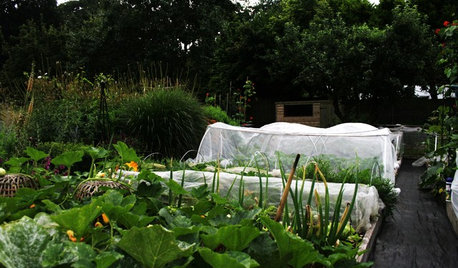Oaks in the Food Forest
Permaculturists are interested in food forests. This article, several years old inspired me to plant a couple dozen of them on the perimeter of our two acre market garden. We grow most of our product on permanently mulched intensive beds and have been earning a living at it for a dozen years. Please visit our website.
John Warner, http:www.wholesystemsag.org
Use of Acorns for Food in California: Past, Present, Future
David A. Bainbridge2
1Presented at the Symposium on Multiple-use Management of California's Hardwoods, November 12-14, 1986, San Luis Obispo, California.
2David A. Bainbridge, Dry Lands Research Institute, University of California, Riverside, CA 92521
Abstract:
Acorns are a neglected food for people, livestock, domestic fowl, and wildlife in California. Acorns are easy to collect, store, and process. In addition to the nutritious nut and meal, acorns yield an oil comparable in quality and flavor with olive oil. The existing acorn market could be greatly expanded and provide new income for rural people. A serious effort to identify and propagate the best oak acorn cultivars for these products is long overdue. It is particularly appropriate for this research to be done in California, which once had an acorn based economy.
INTRODUCTION
Acorns have been used as food by Homo sapiens for thousands of years virtually everywhere oaks are found. The worldwide destruction of the acorn resource by mismanagement may well have led to the development of annual plant based agriculture and to civilization as we know it today (Bohrer, 1972; Bainbridge, 1985b). In Europe, Asia, North Africa, the Mid-East, and North America, acorns were once a staple food, (Hedrick, 1919; Loudon, 1844; Brandis, 1972; Lefvebre, 1900; and Bishop, 1891). The Ch'i Min Yao Shu, a Chinese agricultural text from the sixth century recommends Quercus mongolica as a nut tree (Shen Han, 1982). In Spain and Italy acorns provided 20 percent of the diet of many people just before the turn of the Century (Memmo, 1894).
Acorns were perhaps nowhere more important than in California. For many of the native Californians acorns made up half of the diet (Heizer and Elsasser, 1980) and the annual harvest probably exceeded the current California sweet corn harvest, of 60,000 tons. Acorn foods remain on the market not only in Korea, China, and North Africa, but in most major American cities, at Korean food stores (Wolfert, 1973; Bainbridge, 1985a).
A reevaluation of acorns and their uses is long overdue. The acorns of all 500 species should be tested. Although the acorns of some oaks are probably too small or too hard to open for widespread use many species that can and should be planted for use as food. They are also valuable feed for domestic animals and birds, and wildlife.
The factors that made acorns a major food source in California in the past make them attractive candidates for greater use in the future. They often ripen all at once and are easy to collect. They store well and were kept by the native Californians for several years in simple storage bins (Merriam, 1918). They are simple to prepare, even for the varieties that need to be leached. Although most species are bland, as are corn and wheat; some have good flavor and could be used in place of other nuts.
The yield of acorns per acre compares well with grains. When the long-lived, deep-rooted oaks can reach sufficient water; acorn production can be very high, with yields of more than 5,280 kg/ha (6,000 pounds/ acre) (Bainbridge, 1986). High acorn yields can be maintained on hilly lands where annual grain crops cause severe soil erosion (Bainbridge, 1987a).
ACORN HARVESTING
Harvesting acorns should be very similar to the harvesting of other commercial nuts such as almonds or filberts. Wolf (1945) found that it was possible to collect from 110-660 kg (50-300 lbs) of acorns per hour with very simple hand tools. My own experience has confirmed these numbers. However, when harvesting small acorns, like Q. gambelii, in an off year it may be possible to collect only a few pounds per hour.
ACORN NUTRITION
The nutritional qualities of 18 species of acorns are described in Table 1. California's acorns are described in Table 2.
TABLE 1. ACORN COMPOSITION, 18 SPECIES
Percent
Water 8.7 - 44.6
Protein 2.3 - 8.6
Fat 1.1 - 31.3
Carbohydrate* 32.7 - 89.7
Tannin 0.1 - 8.8
KCAL/100 gms 265 - 577
KCAL/lb 1200 - 2600
* or N free extract
(Bainbridge, 1985a).
TABLE 2. CALIFORNIA ACORNS
Species Water Protein Fat Carbohydrate Tannin
Q. agrifolia1 9.0 6.26 16.75 54.57 --
Q. chrysolepis1 9.0 4.13 8.65 63.52 --
Q. douglasii1 9.0 5.48 8.09 65.50 --
Q. douglasii2 40.75 3.03 4.77 43.39 3.61
Q. dumosa2 44.58 2.29 3.42 40.65 5.15
Q. kellogii1 9.0 4.56 17.97 55.48 --
Q. kellogii2 37.6 3.43 11.05 32.71 1.81
Q. garryanna1 9.0 3.94 4.47 68.87 --
Q. lobata1 9.0 4.90 5.54 69.02 --
Q. lobata2 40.57 2.82 4.25 43.44 3.85
Q. wislizneii2 29.80 3.08 14.47 40.40 4.60
Lithocarpus
densiflora3 36.00 2.06 8.50 38.29 --
Indian corn4 12.5 9.2 1.9 74.4 --
Wheat4 11.5 11.40 1.00 75.4 --
1Wolf (1945), 2Wagnon(1945), 3Heizer and Elsasser (1980), 4Wagnon (1946)
X-ray diffraction showed that the structure of acorn starch from Q. mongolica and Q. crispula fell between that of corn and potatoes. Acorn starch had limited gelatinization at 61-68oC, with gelatinization of Q. crispula lowest and Q. mongolica highest (Kim and Lee, 1976). The amylose content of acorn starch was 27.1 percent, blue value 0.43 and Aldehyde number 1103 (Chung et al., 1975). Acorns are also good sources of some vitamins, with 5 - 54.8 mg of Vitamin C per 100 gm of raw acorn (Djordjevic, 1954; Minieri, 1954). This compares favorably with the Negev lemon, with 58.1 mg per 100 g. Acorns are also an excellent source of Vitamin A, with 180 IU per gm in Q. phellos (King and Titus, 1943). Twenty-seven grams, or less than tenth of pound of acorns, would meet the suggested daily requirement of 5,000 IU for vitamin A. This may prove of great benefit in areas of the world where vitamin A deficiency is common among the poor. Thorough testing of a full range of oak species and oak processing methods may well discover other species with even higher levels of these and other vitamins and trace elements.
Acorns include many essential amino acids, Table 3. (Luk'yanets, 1978; Videl and Varela, 1969). Testing is needed to establish the amino acid content of the California species. Minor deficiencies can probably be rectified with complementary legumes, fish, or meats. When acorns are cooked with ash, to neutralize bitterness, the acorn foods should also be a good source of calcium. Cooking with ash may also make more niacin available if the tests Ruttle (1976), conducted on corn are replicable for acorns. Acorns also supply many trace elements. It is not at all surprising that acorn-based cultures prospered for thousands of years with this excellent food base.
TABLE 3: AMINO ACID CONTENT OF ACORNS
milligrams/gram
Glycine 0.98 - 1.37
Alanine 1.02 - 1.57
Valine 0.97 - 1.22
Leucine 1.69 - 2.08
Isoleucine 0.63 - 0.72
Serine 0.94 - 1.23
Threonine 0.87 - 1.13
Methionine 0.26 - 0.31
Phenylalanine 0.90 - 1.09
Tyrosine 0.68 - 0.99
Lysine 1.19 - 1.51
Arginine 1.48 - 2.25
Histidine 0.71 - 1.05
Proline 1.41 - 1.58
Aspartic acid 2.75 - 3.66
Glutamic acid 3.10 - 4.33
(Luk'yanets, 1978).
EDIBILITY
The acorns from many species of oaks are edible raw, just as they are harvested. Sweet acorns have been reported for Quercus gambelii, Q. mongolica., Q. emoryi, Q. dumosa, Q. vaccinifolia, Q. stellata, Q. virginiana, Q. garryana, Q agrifolia Q. macrocarpa, Q. lobata, Q. pumila, Q. muehlenbergii, Q. alba, Q. michauxii, Q. brandeegei, Q. gramuntia, Q. E'sculus, Q. aegilops, and Q. ilex var ballota (Bainbridge and Asmus, 1986; Bainbridge, 1984; Coyle and Roberts, 1975; Loudon, 1844; Bohrer, 1972; Chestnut, 1974; Brandis, 1972; Hedrick, 1919; Michaux, 1810; Ofcarcik et al., 1971; Smith, 1950; Fray, 1986). Undoubtedly, other species and varieties are equally sweet and more flavorful.
A careful worldwide search for good cultivars is long overdue because there is hope of finding sweet acorns even in those species normally considered bitter. Some of these include the best tasting acorns, with cashew and chocolate overtones.
ACORN LEACHING
It is also practical to harvest and use the bitter varieties. The tannins which causes the bitterness can be leached from acorns or acorn meal with water. Using hot water hastens the process. Studies at Dong-guk University in Seoul, South Korea showed the tannin level was reduced from 9 percent to 0.18 percent by leaching, without loss of essential amino acids, (Kim and Shin, 1975). Virtually all of the acorns the native Californians used were bitter and were leached with water to remove the bitterness. They apparently based their acorn preference on oil content, storability, and flavor rather than sweetness. However, the Cahuilla people in Southern California remember sweeter acorns from their past (in the South-Central U.S.) and consider their loss as a fall from grace, like Adam and Eve's expulsion from the garden (Bainbridge, 1987a).
Native Americans also sweetened bitter acorns with iron-rich red earth, wood ashes, and other ingredients to neutralize the acids. Steaming or baking were sufficient for some acorns (Chestnut, 1974; Kavasch, 1979; and Gifford, 1936).
COOKING WITH ACORNS
Acorn meal can be substituted for corn meal in most recipes (Bainbridge, 1986b). Acorns can also be used in place of chickpeas, nuts, peanuts, and olives in a variety of dishes. Acorn meal and acorn pieces are excellent in soups and stews and were often used that way by native Californians. Acorns can also be treated with pickle brines or the lye treatment used for olives (Wolf, 1945; Bainbridge, 1986b). Acorns have also been used to make coffee-like drinks (Kavasch, 1979). The success of the venture depends on the particular acorn and technique used. Q. muehlenbergii was especially favored for this purpose in the Midwest, (Ofcarcik et al., 1971). Q. robur and Q. frainetto have been used in Europe where the resulting drink is referred to as "Eichel kaffee", or acorn coffee (Sholto Douglas, 1978; Readers Digest, 1984). A similar acorn coffee has been used in Mexico, (Usher, 1974). Raccahout, a spicy Turkish acorn drink more like hot chocolate, was included in the Larousse Gastronomique until recently.
ACORN OIL
Acorns can also be used to make acorn oil by boiling, crushing, or pressing. Acorn oil has been used as a cooking oil in Algeria and Morocco (Loudon, 1844; Hedrick, 1919; Smith, 1950). It was used by the Indians of the eastern U.S. for cooking and as a salve for burns and injuries (Michaux, 1810; Smith, 1950). Some varieties contain more than 30 percent oil, equal or greater than the best oil olives ( Wolf, 1945; Ofcarcik et al., 1971). The quality and flavor of the oil is comparable to olive oil (Wolf, 1945; Smith, 1950; Bainbridge, 1985a). Table 4 presents further information on acorn oil.
TABLE 4. ACORN OIL
Species Quercus Quercus 5 other Olive Corn
agrifolia ilex speciesa
Specific 0.9170 0.9086 0.9100 0.914-.919 0.916-921
gravity
Refractive index 1.4709 1.4701 1.4627 1.466-1.468 1.470-1.474
Saponification 192.3 189.05 191.45 187-196 187-196
value
Olieic acid% -- 57.05 58.31 83.5-84.4 19-49
Palmatic acid% -- 12.40 11.43 6.9-9.4 8-12
Linoleic acid% -- 30.50 37.50 4.0-4.6 34-62
Flash point -- -- 360C 343°C 393°C
aaverage of available data
Acorn data: Jameison (1943), Wolf (1945), Hopkins et al (1953), Khan (1977), Marwat et al (1978).
Olive and corn oil: Weast (1979) and Windholz (1976).
ACORNS AS FODDER
The meal left after pressing oil can be used for animal feed, but the whole acorns are better. They have been used for feeding livestock for many thousands of years. Most acorns, even without leaching, can be fed up to 20 percent of the ration of chickens (Weingarten, 1958; Boza et al., 1966; Varela et al., 1965; Medina Blanco and Aparico Macarro, 1965). Acorn fed bear and hog meat were highly valued in the early days of California settlement. Acorn-fed hogs were especially favored in Italy (Maymone and Durante, 1943). Leached acorns can be used for 50 percent or more of the diet, as part of a balanced diet, and may make up 90 percent of the diet of some California deer herds in the Fall and Winter. In addition, many oak leaves can be fed to livestock and some were eaten by people (Bainbridge, 1985a). Oaks have been grown and maintained primarily for fodder in a number of countries. Q. infectoria for example, was favored in Iraq where it was pollarded for better fodder production (Blakelock, 1950). The tannin in bitter acorns and leaves of some oaks can cause poisoning in livestock if fed in high percentage. Range poisoning sometimes occurs when other forage is limited. For further information on acorn poisoning see (Fowler et al., 1965; Duncan, 1961; Clarke and Cotchin, 1956; McGowan, 1970; Stober et al., 1976).
ACORN USE IN THE FUTURE
With a serious oak selection and breeding effort there is little doubt that oaks that bear early and have large, sweet acorns could be developed for use in most areas of California. Most of the oaks hybridize well, so much could be done by careful breeding. Studies at the University of Utah have demonstrated that the subgeneras will cross, (Cottam et al., 1982), and successful crossing of good flavor and sweetness should be feasible. This type of hybridization work is slow, however, so the rapid development of acorns as a commercial crop will be more dependent on the selection of the best individuals now growing around the world. Good flavor and large sizes can probably be combined. I have found acorns weighing more than 19 gms (Q. chrysolepis) and have been told of even larger acorns. The recent advances in plant breeding and genetics should reduce the time required to develop a plum sized, tasty acorn. Plant breeding might also develop a high yielding, sweet acorn and cork producing tree.
Selection for high productivity may be important for the development of commercial acorn orchards. Single trees have been found producing: more than 908 kg (2,000 lbs.) of acorns, Q. lobata, and consistently several hundred kg (pounds) per year, Q. garryana, Q. agrifolia, Q. ilex, and mixed stands ( Wolf, 1945; Smith, 1950; Beck, 1977). Smith (1950) estimated that commercial oak orchards would produce 1,250 kg of acorns per hectare (1,400 pounds/acre) annually with selected cultivars. I suspect this is a conservative estimate as natural forest yields of 1,300 - 4,400kg per hectare (1,450 - 5,000 lbs/acre) have been recorded for a good acorn crop, (Koenig 1979; Wolf, 1945). I have found up to 5,200 kg/ha (6,000 lb/acre) in a good crop year for Q. kellogii in the Sierra Nevada and similar yields in the forests of Q. chrysolepis in Southern California.
The challenge is first to alert farmers, foresters, and the food industry in California to the potential use of acorns. The second task is to establish a larger market for wild acorns (similar to the black walnut business) and acorn products. At the same time there is a critical need to identify and develop oak cultivars for acorn meal, nut, and oil production. Equipment for harvesting, hulling, and grinding must also be evaluated. It is likely that filbert harvesters and hullers will work but only field trials will confirm this.
Detailed economic analysis of acorn harvesting and processing in California is also needed. Wolf (1945) has done the only study of the California acorn business I am aware of and his results were encouraging. The only modern economic evaluation of acorn harvesting was done in Spain by de Ursinos et al (1969). They determined that the acorn harvest for industrial production of meal and oil had been economically viable when they began their study but was no longer profitable at the end, because of labor cost increases and the release of wild hogs in the study forest.
With current California prices for acorn meal running about $ 0.90/lb wholesale and to more than $30 per gallon for specialty nut oils it seems likely that an entrepreneur could establish a profitable acorn business. This enterprise will be easier to establish if processing and palatability tests are conducted by University researchers. These studies could also refine acorn oil processing techniques and help develop specialty products that can compete in the marketplace.
From my own experience I would think a talented cook/marketeer could make an entrance into the market with acorn chips and crackers or acorn breads and muffins. On a larger scale the market for acorn flour could be much increased and a market for acorn oil could be established. An acorn beer or acorn alcohol could also be prepared.
SUMMARY
The acorn was once the staff of life in most of California and many areas of the world (Bainbridge, 1984; Bainbridge, 1985b; Bainbridge, 1986a). It may become a more common food in California again. It is a perennial "grain" that can be grown on arid and semi-arid lands and steep slopes where annual grains would cause severe environmental degradation.
Further research on acorn composition (particularly vitamins) and flavor, recipes, processing, and oak tree management is needed. The
hardwoods program undertaken in 1986 (Passof and Bartolome, 1985) is an excellent beginning but the resource commitment is small and includes no directives for acorn research.
Material on acorns, acorn recipes, and oaks would be appreciated.
ACKNOWLEDGEMENTS
My special thanks to my parents, who have helped collect and test acorns; to Norma Kobzina for her help in the libraries of UC Berkeley; and to Joan Fray and Peg Carkeet for their support and encouragement in collecting and tasting acorns. The help of Dana Sowers, John Gibson, and Catherine Gring is also appreciated, and special thanks to Stanley Scher for his review.
















brendan_of_bonsai
marshallz10
Related Professionals
Hartford Landscape Contractors · Salem Landscape Contractors · Americus Landscape Contractors · Bristol Landscape Contractors · Indianapolis Landscape Contractors · Long Branch Landscape Contractors · Lorain Landscape Contractors · Newnan Landscape Contractors · Panama City Beach Landscape Contractors · Porterville Landscape Contractors · Camp Springs Siding & Exteriors · Massapequa Siding & Exteriors · Saco Siding & Exteriors · Muscatine Solar Energy Systems · Rockledge Solar Energy SystemsflowermanoatOriginal Author
marshallz10
arijah
hangtown_frank
flowermanoatOriginal Author
hangtown_frank
Belgianpup
Belgianpup
flowermanoatOriginal Author
burra_maluca